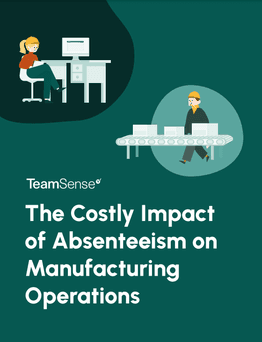Fix the root cause of No-Call No-Show with help from TeamSense
Table of Contents
Employee engagement isn’t just a buzzword—it’s the foundation for building a reliable, motivated team. Emphasis on the word reliable.
When you have an engaged workforce, you have a team that shows up, steps up, and takes pride in their work. And that reliability? It’s priceless, especially when you're navigating the challenges of HR and operations, like no calls no shows.
The truth is, when engagement is high, dependability follows. But it’s easy for the demands of everyday work to overshadow the need for employee engagement initiatives. One of the first things to fall by the wayside is often nurturing your team and keeping engagement strategies front and center. If you’re seeing more no call no shows or rising turnover, it might be time to look inward and identify what’s missing.
Understanding 'No Call No Show'
A "no call no show" happens when an employee fails to report to work without notifying anyone. This leaves managers scrambling to find a replacement or redistribute the workload among other team members, leading to decreased productivity, overworked staff, safety risks, and unhappy customers.
Consequences of No Call No Shows
The consequences of no call no shows can be far-reaching. In the short term, it can lead to:
- Decreased productivity
- Increased stress on other employees
- Potential safety risks due to understaffing
- Dissatisfied customers or clients
Over time, frequent no call no shows can result in:
- Higher turnover rates
- Lowered morale among the remaining workforce
- Damage to the company's reputation
- Financial losses due to reduced output or increased overtime costs

The Costly Impact of Absenteeism on Manufacturing Operations
Learn how chronic, unplanned absenteeism is a costly impediment to manufacturing productivity and efficiency, and how you can reduce absenteeism.
Why No Call No Shows Happen
To effectively address the issue of no call no shows, it's essential to understand the underlying reasons behind this behavior. Some of the primary causes include:
- Lack of engagement: Disengaged employees are more likely to skip work without notice. They may feel disconnected from their job, their team, or the company's mission, leading to a lack of motivation and accountability.
- Poor communication: When there are no clear guidelines or channels for reporting absences, employees may be unsure of how to properly notify their supervisor. This can be especially true for new hires or in organizations with unclear attendance policies.
- Burnout and work-life imbalance: Employees who are overworked, stressed, or struggling to juggle personal responsibilities may resort to no call no shows as a way to cope. Without sufficient support or flexibility, they may feel that skipping work is their only option.
- Lack of recognition and career development opportunities: When employees feel that their contributions are not valued or that there is no path for growth within the company, they may become disengaged and less committed to their job. This can manifest as increased absenteeism, including no call no shows.
What Employee Engagement Really Looks Like
Employee engagement is the secret ingredient that transforms an ordinary job into an extraordinary experience. It’s the level of enthusiasm and dedication an employee feels toward their work and their company. Engaged employees go the extra mile, bringing energy and creativity to their tasks and contributing to a positive workplace atmosphere.
At its core, engagement is about more than just job satisfaction. It’s about feeling valued and connected to the mission of the organization. Engaged employees don't just perform tasks—they understand the importance of their work and how it fits into the broader company goals, leading to higher productivity and innovation.
Several key elements foster this kind of vibrant engagement:
- Clarity of Role and Impact: Employees thrive when they clearly understand their roles and see the tangible impact of their work on the company's success. This clarity fuels motivation and a sense of belonging.
- Celebration of Contributions: Recognizing employees for their achievements boosts their morale and commitment. Whether through formal awards or informal praise, acknowledgment reinforces their value to the organization.
- Pathways for Development: Providing opportunities for skill enhancement and career progression encourages employees to invest in their future with the company. This could be through mentoring programs, workshops, or clearly defined career paths.
- Transparent Communication: Establishing open lines of communication builds trust and cohesion. Employees who feel informed and heard are more likely to engage fully with their roles.
- Wellness and Support: A workplace that prioritizes employee well-being and offers flexibility is one where engagement flourishes. This includes supporting mental health and promoting a balanced approach to work and life.
5 Strategies to Boost Employee Engagement and Prevent No Call No Shows
Enhancing employee engagement is a game-changer in minimizing unexpected absences and building a dependable workforce. By integrating specific strategies, organizations can drive commitment and foster an environment where attendance issues are minimized.
1. Foster Open Communication
Open communication is the foundation of a strong, engaged team. Create opportunities for employees to share their thoughts and concerns and keep everyone in the loop with regular updates.
- Structured Forums: Hold regular all-hand meetings or retros, or focus groups where employees feel comfortable speaking up. This kind of open dialogue helps prevent misunderstandings before they turn into bigger issues.
- Consistent Updates: Keep the team informed with regular updates on company news and changes. When employees know what’s going on, they’re more likely to stay engaged and feel connected to the company.
2. Create a Positive Workplace Culture
Cultivating an inviting workplace isn't just about boosting morale—it’s a strategic approach to ensure employees are excited to come to work. A vibrant culture helps employees feel connected and motivated.
- Cultivating Respect: Respect and inclusion should be the cornerstones of your workplace culture. Activities and training sessions that promote understanding and teamwork help create an environment where everyone feels valued.
- Aligning Goals: Show employees how their work contributes to the bigger picture. When people understand how their efforts support the company’s mission, they’re more engaged and committed.
3. Implement Flexible Scheduling
Flexible scheduling helps reduce stress and promote work-life balance. By allowing employees to tailor their work hours, you create an environment that respects their personal needs while boosting focus and productivity.
- Personalized Work Hours: Offer flexible start and end times to accommodate individual preferences. This makes it easier for employees to manage their personal and professional responsibilities.
- Job Sharing Options: Allow two employees to share one role where possible. This helps with scheduling conflicts and also fosters teamwork.
4. Recognize and Reward Attendance
Building a dependable workforce takes more than just rules—it’s about celebrating those who consistently show up and do their best. Acknowledging reliable employees creates a culture where attendance is valued and rewarded.
- Spotlight Achievements: Publicly recognize employees who maintain great attendance. Highlighting their efforts in newsletters or on bulletin boards can motivate others.
- Reward Systems: Offer small bonuses, extra leave days, or other incentives for employees with outstanding attendance. It’s a simple way to show appreciation and encourage others to follow suit.
5. Support Employee Well-being
Focusing on employee well-being is like building a solid foundation—if employees are taken care of, everything else falls into place. By supporting both mental and physical health, companies show that they truly care about their people.
- Comprehensive Health Resources: Provide access to health screenings, fitness classes, and mental health support. This shows employees that their well-being is a priority.
- Encouraging Balance: Create a work environment that respects personal time. Offer flexible vacation policies or designate "unplugged" days to help employees recharge and avoid burnout.
Leveraging Technology to Boost Engagement and Address Absenteeism

Attendance Management Tools
In today’s digital age, technology has transformed how companies manage attendance. Streamlined tools make it easier for HR professionals to monitor attendance while offering valuable insights to tackle absenteeism.
Automated systems provide real-time tracking and reporting, reducing human error and boosting accuracy. Features like biometric verification and geofencing make it easy for employees to log their hours and stay accountable. Plus, these systems integrate seamlessly with payroll and HR platforms, improving overall efficiency.
- Instant Alerts: Automated systems provide immediate alerts for attendance issues, allowing managers to address problems swiftly and maintain workflow continuity.
- Comprehensive Analytics: These tools offer detailed analytics that highlight trends and patterns, empowering HR teams to proactively manage attendance challenges.
- Employee Portals: Self-service portals empower employees by allowing them to access their schedules and attendance records, fostering a culture of openness and empowerment.
Managing No Call No Shows with TeamSense
Using technology like TeamSense in your attendance management strategy can make a big difference. TeamSense simplifies the process, allowing employees to notify their supervisors via text without needing extra apps. This simplicity makes communication easy and reduces unexpected absences.
- User-Friendly Interface: The straightforward process makes it easy for employees to report absences, ensuring quick communication and reliable attendance.
- System Integration: TeamSense works seamlessly with existing HR systems, consolidating data for a complete view of attendance patterns.
- Boosting Engagement: By reducing communication barriers and simplifying the attendance reporting process, TeamSense fosters a culture of transparency and accountability. Employees feel more connected and are more motivated to manage their attendance proactively.
Boosting Efficiency: A 3PL Company Slashes Absenteeism by 39% with TeamSense

TeamSense changed the way this 3PL handled absenteeism, resulting in significant improvement in absenteeism rates, and can help your company too!
Final Thoughts
Tackling the no call no show issue requires more than just enforcing policies. It’s about creating an environment where employees feel valued, supported, and connected to the company’s mission. When people feel their roles matter and their well-being is a priority, unexpected absences become less common, and the team becomes more reliable.
By fostering open communication, building a positive workplace culture, offering flexibility, recognizing great attendance, and supporting well-being, companies can create a team that’s not just present but truly engaged and eager to contribute.
Dealing with no call no shows is a continuous journey, but every step you take helps build a more committed and reliable workforce. By focusing on employee experience, you can create a culture where attendance is the norm and motivation is sky-high.
Take the Next Step
Ready to boost employee engagement and reduce unexpected absences? Book a demo today to see how our solution can streamline your attendance process and help you build a more engaged, dependable workforce.
About the Author

Jackie Jones, Employee Engagement & Attendance Specialist
Jackie Jones has over three years of experience helping HR teams improve employee morale, reduce absenteeism, and create happier, more engaged workplaces. With a strong background in employee relations and attendance management, she brings practical strategies and insights that support frontline teams and the HR professionals who lead them.


